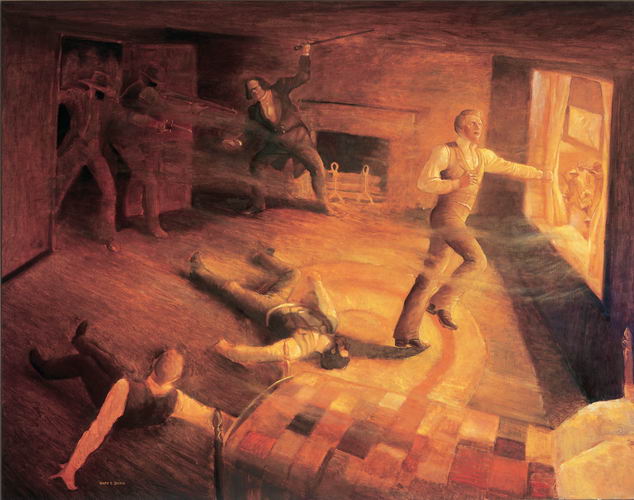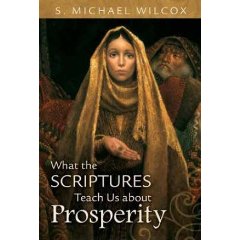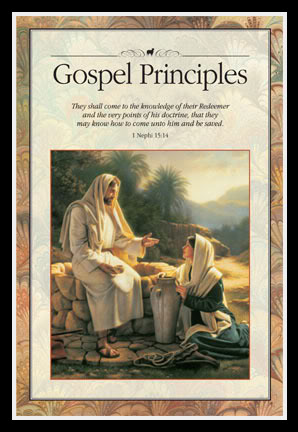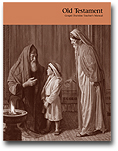Author: Dave Banack
-
A Writer on Science and Religion
In this final installment of this month’s series of posts on religion and science, I will present a different take on things from the perspective of a celebrated writer. Marilynne Robinson won a Pulitzer Prize in 2005 for her novel Gilead. She also delivered the Terry Lectures at Yale in 2009, resulting in the book…
-
Science and Religion: Enemies or Partners?
For the next installment in this set of posts, let’s consider the relation between science and religion. In a mildly tedious but well-organized book, When Science Meets Religion: Enemies, Strangers, or Partners? (HarperCollins, 2000), Ian Barbour lays out four basic forms that the relation between science and religion can take: Conflict (either science or religion…
-
Correlation is Killing Sunday School
Once upon a time, there was Sunday School, an independent auxiliary whose officers were appointed by senior LDS leaders and whose primary task was to develop a Sunday School curriculum, and commission and supervise the writing of lesson manuals. They did a nice job. Then came Correlation.
-
Jonah, overboard.
If you haven’t heard the story in Sunday School yet, you will shortly (Jonah 1). Surprisingly, the combination of God and bad weather is still a potent force in the modern era — my stake was praying for rain earlier this year. But here is a more colorful Jonah-like account with sailors, storms, and witches…
-
An LDS View on Science and Religion
Continuing the conversation begun in my earlier post (God and Science), let’s look at the Encyclopedia of Mormonism entry titled “Science and Religion.” It provides a good summary of what might be termed the conservative LDS position on the topic. The article opens on a positive note: “Because of belief in the ultimate compatibility of…
-
God and Science
The conflict between science and religion is generally overstated. But it is certainly true that science is the matrix that most people of our day — believers or not — use as the basis for understanding the natural world we live in. Atheists and agnostics stop there; believers add a supplemental layer of faith to…
-
Myth and Ritual
Like some of you, I’ve been reading a book or two on the Old Testament, this year’s Sunday School course of study. Most recently I read Susan Niditch’s Ancient Israelite Religion (OUP, 1997), described in the jacket blurb as “a perceptive, accessible account of the religious beliefs and practices of the ancient Israelites.” Too often…
-
Where Is Mormonism Headed?
That theme is addressed from many different angles in The Future of Mormonism series at Patheos. It might be the best online event on Mormonism I’ve seen, with contributors drawn from across the Mormon spectrum. Here are a few highlights. Mormonism in the New Century by Armand Mauss — Mauss sees the retrenchment-assimilation pendulum swinging…
-
Perceptions of Mormonism
The Deseret News posted an article (“Mormons need to work to increase favor“) summarizing remarks by Gary Lawrence at the recent FAIR Conference held last week in Sandy. He addressed perceptions of Mormonism, based on data gathered by his polling firm. We’ve got some problems, it seems.
-
Ripples in History
I recently finished Victor Davis Hanson’s Ripples of Battle (Doubleday, 2003), with the give-it-all-away subtitle How wars of the past still determine how we fight, how we live, and how we think. Generalizing a bit, not just wars but many major events and some small, unnoticed ones send ripples into the future, silently influencing future…
-

What Did We Lose?
In 70 AD, the Romans capped their extended campaign to crush a Jewish revolt by destroying the magnificent temple in Jerusalem. The Jews lost their temple. Earlier, they had lost political autonomy and the kingship; later, in 132 AD, another Jewish revolt was suppressed and Jews were barred from living in or even entering Jerusalem.…
-

The End of the World
I took a stroll through the End of the World last week. Brought the wife and kids and a picnic lunch. It was beautiful, as always. But one of these days (and it won’t be long) it will be gone. Maybe us too.
-
New Mormon Blog at Beliefnet
Jana Reiss, former T&S guest blogger and author of Mormonism for Dummies, is running a new Mormon blog at Beliefnet: Flunking Sainthood. Put a link in your blogroll (do people still do blogrolls?) and visit often. Having myself previously hosted a Mormon blog at Beliefnet, I have some idea of the challenge the new blog…
-
Inoculation Works
I finally picked up and read a copy of Simon Southerton’s Losing a Lost Tribe: Native Americans, DNA, and the Mormon Church (Signature, 2004) a couple of weeks ago. Yet I still attended church last week and have not drafted a resignation letter. Inoculation works. There’s nothing particularly new in the book — it summarizes…
-

A Peek Inside the Temple
On May 28, a press conference was held in the South Visitors’ Center on Temple Square to unveil a new public exhibit: a cut-away scale model showing the interior architecture and layout of the Salt Lake Temple. The LDS Newsroom and Deseret News posted detailed stories with additional images; in this post I just want…
-
Review: Losing My Religion
I admit that when approaching William Lobdell’s Losing My Religion: How I Lost My Faith Reporting on Religion in America — and Found Unexpected Peace (HarperCollins, 2009), I expected the standard debunking treatment that is so familiar in news and entertainment media these days. Instead, I was pleasantly surprised to find a balanced and engaging…
-
Beliefs and Causes
Beliefs are complicated and sometimes strangely resistant to facts. I don’t mean religious beliefs in particular, but everyday beliefs about how the world works and how it is that we come to hold them. That’s what I took away from a recent reading of Lewis Wolpert’s Six Impossible Things Before Breakfast: The Evolutionary Origins of…
-
Priesthood Session in a Nutshell
President Eyring conducted, with music by a BYU priesthood choir (with an expressive and energetic conductor) and talks by Elder Oaks, Elder Rasband, YM President Beck, and the First Presidency. This was an amazingly upbeat meeting. President Monson called this one of the best priesthood meetings he ever attended.
-
Sleep, Success, and Seminary
Sleep: it’s more important than you think, especially for teenagers. Here’s from George Will’s latest column, “How to ruin a child“: Only 5 percent of high school seniors get eight hours of sleep a night. Children get an hour less than they did 30 years ago, which subtracts IQ points and adds body weight.
-
Genesis and Genre
When we read Genesis, what exactly are we reading? The distinctions and categories we modern readers bring to books and narratives (fiction or nonfiction; science or folk tale; history or literature; poetry or prose; author’s original text or quoted source) may not serve us well when we read the Old Testament, a collection of ancient…
-
Lineage: A Troubling Concept
Here’s a quote from Lesson 7, “The Abrahamic Covenant,” that caught my attention in Sunday School: The great majority of those who become members of the Church are literal descendants of Abraham through Ephraim, son of Joseph. Those who are not literal descendants of Abraham and Israel must become such, and when they are baptized…
-

Mormons and Prosperity
The Prosperity Gospel (which the linked Wikipedia article defines as “the notion that God provides material prosperity for those he favors”) is often associated with Evangelical megapreachers. [Note 1.] But we all know there is a Mormon variation of the Prosperity Gospel lurking behind the ubiquitous references to blessings and how to earn them that…
-

Underwhelming Thoughts on Correlation
I confess that I am not a regular reader of the Church News, but I did happen to run across this recent piece, “Using proper sources.” I will note a couple of quibbles I have with the piece (which, as an unsigned post in the “Viewpoints” section, I take to be essentially a staff editorial),…
-

Good Thoughts on Teaching Sunday School
My second-favorite group blog recently posted a series on what’s wrong with Sunday School, showing once again that we bloggers are, if nothing else, talented complainers. So let’s talk teaching and collect a few simple suggestions for improvement.
-
Calling All Introverts
There’s hope! At least that’s the message of a couple of posts I read through lately (here and here) presenting an interview with Adam McHugh, the author of Introverts in the Church: Finding Our Place in an Extroverted Culture. By “Church” he means Evangelicals, not the LDS Church, but the discussion is still relevant to…
-

Do We Need A Fifth Mission?
The news is out that LDS leaders are adding a fourth mission for the Church: caring for the poor and needy. According to an official LDS spokesman cited in the Salt Lake Tribune article, the new mission (or purpose or emphasis) will be included in the new edition of the Handbook of Instructions to be…
-

December: Preparing for the Annual Sunday School Curriculum Reboot
In the Church, December means different things to different people. If you’re three, you will soon be exiled from that zone of energetic irreverence known as Nursery to your first real class, Sunbeams. If you’re a bishop, holiday cheer is tempered by the month-long grind of tithing settlement. But one change we all look forward…
-
Your View of Mormons in the Media
I recently had a short discussion with a journalism student about how Mormons and Mormonism get covered in the mainstream media and whether new online media, including blogs, do any better. I’ll summarize my responses below, but I invite readers to offer their own responses in the comments. 1. How do Mormons feel about increased…
-
What Happened in Nauvoo, Part 3: Polygamy
[See Part 1: Founding and Part 2: Flourishing] Any history of Nauvoo needs to give an account of the secret practice of polygamy between 1841 and 1846. In Nauvoo: A Place of Peace, a People of Promise, Glen Leonard does this in about twenty pages as part of Chapter 13, “Foes Within: The Church of…
-
Hope and Children
Faith and charity get plenty of attention, but hope not so much. Pessimism, it seems, has become one of the guiding principles of modernity, reflected in the media, popular culture, and even academia. So I was surprised to find a philospher making the suggestion that children anchor our hope for progress and our conviction that…
